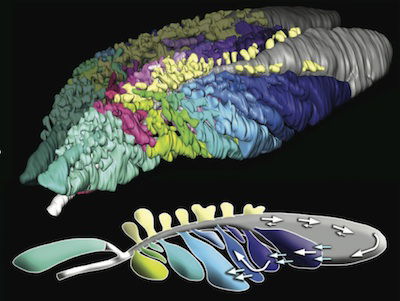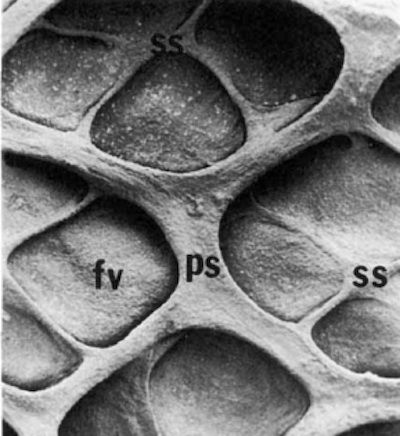
Lizard Breath Fails to Support Kinship with Birds
News to Know
Abstract
Do monitor lizards and crocodiles really breathe the same way birds do?
News Source
- Nature: “Why Lizards May Inherit the Earth”
Birds have a unique respiratory system. They combine unidirectional airflow with bellows-like extra-pulmonary air sacs scattered throughout their bodies in which fresh air is briefly stored. With this arrangement birds continuously extract oxygen from fresh air. This completely flow-through air delivery system gives birds the most efficient respiratory system on earth.
Unidirectional Airflow—Not Just for Birds after All
Unidirectional airflow is not unique to birds. University of Utah’s Colleen Farmer in 2010 discovered air flows in a unidirectional loop in the American alligator’s lungs. The recent discovery that not only the Nile crocodile but also the African savannah monitor lizard also has unidirectional airflow in some sections of the lungs has evolutionists reconsidering the branch points in reptilian and bird lineage. They’re also puzzling over why unidirectional airflow evolved. Evolutionary scientists hope these discoveries will shed light on how dinosaurs breathed.

This is an African savannah monitor lizard (Varanus exanthematicus). In the same group as the Komodo dragon, the largest living lizard, this species, only about 15 inches long and weighing about a pound, is considerably more convenient to work with. Like the American alligator and the Nile crocodile, this lizard combines unidirectional and tidal breathing. This was a surprise to scientists, who used to think unidirectional breathing only existed in birds. That is where the similarity to birds ends, however. Airflow in birds is fully unidirectional, and numerous other features combine to make avian respiration unique. Image: Daniel Bennett through Wikipedia Commons.

The upper illustration is a colorized 3-D CT scan of the monitor lizard’s lungs showing many laterally branching airways in various colors. The lower sketch is a longitudinal cross-section showing that some of the airflow is in a unidirectional loop. Air moves from the trachea on the left into a number of lateral bronchi. Perforations in these bronchi allow air to move across through these branches, maintaining a fairly steady air pressure throughout the respiratory cycle. Airflow is tidal in other parts of the lungs, though this is not shown in these diagrams. Though unidirectional airflow results from the aerodynamics inherent in the arrangement of the airways in the more proximal parts of the lungs, the overall anatomy differs substantially from that of birds. Image: Emma Schachner, University of Utah, doi:10.1038/nature12871

Birds do not have these. This is a scanning electron micrograph of the alveoli-like faveoli in which savannah monitor lizards absorb oxygen from air. As in mammals, fresh and “old” air must mix in such dead-end terminal gas exchange sacs. Along with the presence of a diaphragm and the absence of air sac reservoirs outside the thoracic cavity demarcated by the diaphragm, these faveoli emphasize the essential un-birdy-ness of reptilian breathing (fv=faveolus; ps & ss are primary and secondary septa separating the faveoli). Image: J. N. Maina et al., “Scanning electron microscope study of the morphology of the reptilian lung: The savanna monitor lizard Varanus exanthematicus and the pancake tortoise Malacochersus tornieri,” The Anatomical Record 224, no. 4:514–522 (August 1989, republished online 26 January 2005), doi:10.1002/ar.1092240409.

This diagram shows the location of many bellows-like air sacs in a bird. Unlike anything found in alligators or lizards, these air sacs are scattered throughout the body. They are supported by attachments to skeletal structures so that they will not collapse. They hold fresh air until the bird exhales, when they are squeezed to provide the bird’s gas exchanging parabronchial tubes with fully oxygenated air. Image: Courtesy of Dr. David Menton.
How We Breathe
Mammals breathe in and breathe out, as we do. This is called tidal breathing because, as with the ocean tide, air flows in and back out along the same path. Movement of the diaphragm expands the chest cavity to draw air in. Fresh air travels in through airways that subdivide until they dead-end in alveoli, tiny sacs where oxygen is transferred into blood and carbon dioxide into the air. Fresh air and “old” air mix during tidal breathing. Exhaled air travels back out the same way it came in.
How Birds Breathe
A bird has no diaphragm and no alveoli. Without a diaphragm, the bird’s chest cavity does not expand. No diaphragm is needed because fresh air flows through without ever backtracking. This is called unidirectional airflow, and until 2010 unidirectional airflow had only been observed in birds. No alveoli are needed because avian gas exchange takes place in the walls of tubular parabronchi through which air continuously flows.
As a bird inhales, oxygen is absorbed through the walls of these parabronchi, but some of the fresh air bypasses them and travels to air sacs elsewhere in the body. No gas exchange takes place in these air sacs, which are supported by adjacent skeletal structures to prevent their collapse. These air sacs are reservoirs for fresh air. Then, while a bird exhales “old” air, its muscular and skeletal movements push fresh air from these air sacs back through the parabronchi.1 Thus the bird absorbs oxygen from fresh air even while exhaling. Fresh and “old” air never mix as they do in mammals. There is never a time during the bird’s breathing cycle when it is not absorbing oxygen from fresh, fully oxygenated air.
How Crocodilians and Monitor Lizards Breathe
Reptiles have diaphragms to pull air into the chest. They also have have alveolar-type sacs for gas exchange.2 Birds have neither. Therefore, until recently, it was assumed that reptiles were tidal breathers like mammals. After all, reptiles’ chest cavities do expand to draw in air.
“When you pull the lungs out [of the monitor lizard] it just looks like a bag with chambers. It doesn’t look anything like the bird lung,” says Emma Schachner, lead author of the newest studies on monitor lizards and Nile crocodiles. CT scans of the monitor lizard lung showed the arrangement of the airways, but the direction of airflow could only be established by implanting airflow meters in the airways of living animals and by pumping saline containing video-trackable particles through the lungs of dead ones.
Schachner and Farmer3 found that the main airways in monitor lizards and crocodiles branch off into many perforated sac-like tubes (called parabronchi). Because these tubes lie side by side, air travels through the perforations in them. Air loops from tube to tube in this part of the lung without backtracking whether the animal is inhaling or exhaling. Thus, airflow in this part of the reptilian lung is unidirectional.
| How They Breathe | ||
|---|---|---|
| Mammals | Birds | Reptiles |
| No unidirectional airflow | Completely unidirectional airflow | Partial unidirectional airflow |
| Completely tidal airflow | No tidal airflow | Partial tidal airflow |
| Diaphragm | No diaphragm | Diaphragm |
| Fresh and “old” air mix | Fresh and “old” air never mix | Fresh and “old” air mix |
| No air sacs | Air sacs throughout the body | “Air sacs” in lungs only |
| Alveoli | No alveoli | Faveoli (like alveoli) |
| Gas exchange in alveoli (dead-end sacs) | Gas exchange in parabronchi tubes | Gas exchange in faveoli (dead-end sacs) |
| Femur outside body and has nothing to do with breathing | Femur inside body and essential to breathing | Femur outside body and has nothing to do with breathing |
No gas exchange takes place in reptilian parabronchi as it does in bird parabronchi. Instead, air continues farther on through the airways until it dead ends in alveoli-like faveoli. Gas exchange takes place—like it does in mammals—in these faveoli. Fresh and “old” air mix here as they do in mammals.
These distinctions highlight the “un-birdy-ness” of reptile lungs. Reptiles also lack the air sacs that birds have scattered all over their bodies. Furthermore, Farmer was originally puzzled about how a diaphragm, which is associated with tidal breathing, could even exist in a reptile whose airflow was unidirectional. Now that Farmer and Schachner have learned that reptilian unidirectional breathing only takes place in certain parts of the lungs. the diaphragm makes sense. These reptiles combine unidirectional and tidal breathing.
Many writers are now emphasizing the “birdy-ness” of reptilian breathing. However, no matter how “birdlike” some call this reptilian form of unidirectional breathing, it’s almost a sideshow to the real business of breathing, which requires getting air to the alveolar-like sacs for gas exchange. Monitor lizards, alligators, and crocodiles breathe in a way that differs from both birds and mammals, combining some principles from each with their own unique anatomical features.
Evolutionary Significance
Because evolutionists had assumed unidirectional breathing evolved to support warm-blooded birds’ aerial lifestyle, its discovery in cold-blooded animals left them reconsidering when and why unidirectional breathing evolved. Farmer has suggested alligators evolved unidirectional airflow patterns to help them hold their breath underwater for a long time.
The discovery of unidirectional airflow in an alligator prompted evolutionists to conclude the pattern evolved millions of years before birds. The recent discovery of similar air movement in a lizard, which occupies a different time in the evolutionary version of the reptile lineage, has raised new questions. As evolutionists tried to pinpoint when and why unidirectional breathing evolved, they had correlated it with the supposedly low oxygen content of the ancient earth, thinking that this looping airflow may have evolved to enable reptilians to breathe in a more hypoxic world.
Evolutionists consider the revelation about monitor lizard breathing a “mystery” because there is now a mismatch between dates associated with the new ancestral animals and the conditions that supposedly prevailed on earth at the time they presumably lived, as much as 279 million years ago.4 Of course, the notion that photosynthesizing life-forms had to evolve to fill the early earth with oxygen and the idea that any kind of animal evolved into any other kind are worldview-based assumptions without basis in observable facts.
As with most cross-kind similarities, evolutionary explanations either propose early evolution at the base of branching lineages or multiple episodes of convergent evolution. In this case, the feature being tracked isn’t even a structure, since reptile and bird lungs are structurally very different. What is being tracked through evolutionary history is unidirectional airflow. Anatomically, bird and reptiles achieve unidirectional airflow in different ways, and reptiles even combine unidirectional with tidal breathing. Nevertheless, Schachner writes, “Determining when unidirectional airflow first evolved has implication for understanding both the origin and function of respiratory patterns in non-avian reptiles, as well as reconstructing lung physiology and morphology in extinct taxa [namely, dinosaurs].”5
It is impossible to be certain how dinosaurs breathed, and speculation is perpetually colored by the assumption that birds descended from them. Even with extant animals in which the soft tissues can be subjected to examination and experimental manipulation, elucidating pulmonary physiology is challenging, requiring more than knowledge of the anatomy.6 Dinosaur respiratory anatomy is simply not preserved, and without live animals to examine, even if the soft tissues remained, the full physiological story would remain uncertain.
In an effort to show that birds—with their hollow bones and bellows-like air sacs—are related to dinosaurs, much has been made by some writers about the pneumaticity (apparent air spaces) of some dinosaur bones. However, even if these spaces are real features of dinosaur anatomy and not just artifacts of the fossilization process, there are no fossilized channels suggesting links of these spaces to lungs. Schachner and Farmer discount any respiratory significance to this pneumaticity. They conclude, “Postcranial pneumaticity has been purported to be equivocal evidence at best for patterns of air flow, lung efficiency, thermoregulatory strategies, and exercise capacities because pneumaticity has no known function in respiration or gas exchange.”7 Furthermore, Nile crocodiles do not display any such pneumaticity in their bones.
Designed by God
Common design features, whether structural or functional, appear in different kinds of creatures. Why? Because all were designed by a common Designer. Nothing about the repetition of common designs or their appearance in diverse places in the biological world demonstrates evolutionary ancestry. Mammals breathe tidally, birds breathe 100% unidirectionally, and reptiles (at least the alligator, crocodile, and monitor lizard) have respiratory systems combining features of both. When we understand that none of these creatures had to evolve these features, their similarities and diversity make perfect sense.
Our common Designer used both common and unique designs in diverse ways to created fully functional animals, no evolution needed.
Monitor lizards, though cold-blooded, have “one of the highest rates of oxygen consumption ever recorded”8 for a reptile. They not only draw air into their lungs with their diaphragm (like we do) but also push more air into their lungs by expanding their throats to pump more air into their windpipes. It may be that this airway arrangement is particularly important to the energetic monitor lizard. Or it may turn out that many other reptiles use similar pulmonary physiology every time they take a breath. More research is needed to discover which animals move air this way as well as to elucidate just what advantages this mechanism conveys. But nothing about the similarities and differences of different kinds of reptiles and birds can possibly establish an evolutionary lineage for them.
During the recent Ken Ham-Bill Nye Debate, Ken pointed out the difference between historical science—the interpretation of scientific data to draw conclusions about our origins—and observational science. Studies like these can tell us much about the way various animals breathe. But no biologist has ever observed one kind of animal evolving into another. A historical record of9 the past is essential to interpreting the physical evidence of the present to come to correct conclusions about the origins of what we see. The historical record of our origins, God’s eyewitness account in the Bible, gives us the essential information if we wish to know something about the origins of these breathing systems.
God created all kinds of creatures about 6,000 years ago during two literal days, the 5th and 6th days of Creation Week just a few days after He created an atmosphere and plants. He created animals to reproduce after their kinds, not to evolve into different kinds. That historical account enables us to understand that our common Designer used both common and unique designs in diverse ways to created fully functional animals, no evolution needed.
Further Reading
- Did Dinosaurs Turn into Birds?
- What Are “Kinds” in Genesis?
- An Initial Estimate toward Identifying and Numbering the Ark Turtle and Crocodile Kinds
- Turtles Still Baffle Evolutionists
- Komodo Dragon
For More Information: Get Answers
Remember, if you see a news story that might merit some attention, let us know about it! (Note: if the story originates from the Associated Press, FOX News, MSNBC, the New York Times, or another major national media outlet, we will most likely have already heard about it.) And thanks to all of our readers who have submitted great news tips to us. If you didn’t catch all the latest News to Know, why not take a look to see what you’ve missed?
(Please note that links will take you directly to the source. Answers in Genesis is not responsible for content on the websites to which we refer. For more information, please see our Privacy Policy.)
Footnotes
- Birds—unlike any other animal—have skeletons designed with the femur inside the body. The femur helps keep the air sac reservoirs from collapsing, and the muscles attached to the femur help pump air through this system. The position of the avian femur and associated muscles is fundamental to their respiratory physiology. Quick et al., “Cardio-pulmonary anatomy in theropod dinosaurs: Implications from extant archosaurs.” Journal of Morphology (online 20 May 2009), doi:10.1002/jmor.10752 and www.sciencedaily.com/releases/2009/06/090609092055.htm.
- Monitor lizard gas exchange takes place in terminal (dead-end) gas exchange alveoli-like sacs called faveoli, which are larger and more honeycomb-like than mammalian alveoli.(from J. N. Maina et al., “Scanning electron microscope study of the morphology of the reptilian lung: The savanna monitor lizard Varanus exanthematicus and the pancake tortoise Malacochersus tornieri,” The Anatomical Record (August 1989, republished online 26 January 2005) 224, no. 4:514–522, doi:10.1002/ar.1092240409. The anatomy of the terminal airways and physiology of gas exchange in these animals was not the focus of the current research, which dealt primarily with airflow in the proximal airways. Farmer writes, however, “Crocodilian lungs are distinct from bird lungs and are thought to have a large alveolar-arterial blood gas difference . . .” (from C. Farmer et al., “Unidirectional Airflow in the Lungs of Alligators,” Science 327 (15 January 2010):338–340, doi: 10.1126/science.1180219).
- Much supplementary information for this article was obtained from the original journal articles. They include E. Schachner et al. “Unidirectional Pulmonary Airflow Patterns in the Savannah Monitor Lizard,” doi:10.1038/nature12871; E. Schachner et al., “Pulmonary Anatomy in the Nile Crocodile and the Evolution of Unidirectional Airflow in Archosauria,” PeerJ (26 March 2013), doi:10.7717/peerj.60; and C. Farmer et al., “Unidirectional Airflow in the Lungs of Alligators,” Science 327 (15 January 2010):338–340, doi: 10.1126/science.1180219.
- “The Mystery of Lizard Breath,” The University of Utah News Center, December 11, 2013, https://archive.unews.utah.edu/news_releases/the-mystery-of-lizard-breath/.
- Schachner et al. “Unidirectional Pulmonary Airflow Patterns.”
- Anatomy is the structure. Physiology is how it works. Pulmonary (lung) anatomy can provide a map of the airways and dead-ends, but physiological knowledge of how the air moves during respiration and how oxygen is absorbed requires testing in a live, or at least a recently alive, animal.
- Schachner et al., “Pulmonary Anatomy in the Nile Crocodile.”
- Schachner et al. “Unidirectional Pulmonary Airflow Patterns.”
- In diagnostic medicine, a physician examines evidence in the present to determine how a problem developed in the past. This information often sheds light on what is wrong in the present. This diagnostic process is called “a history and physical.” (I use this analogy because I am a physician.) Even with the benefits of modern technology, a good physician recognizes the importance of patient history in correctly interpreting medical data. There are times of emergency when we must simply “see problem/react to problem,” but ultimately knowing how a problem developed and how best to deal with it requires history from the patient or other witnesses. If, for instance the source of an unusual infection is being sought, those witnesses may include family members or even some sort of records documenting where a person has been. But the witnesses to the past are essential to interpreting the physical evidence of the present and coming to correct conclusions about the origin of the patient’s problem.
Recommended Resources

Answers in Genesis is an apologetics ministry, dedicated to helping Christians defend their faith and proclaim the good news of Jesus Christ.
- Customer Service 800.778.3390
- © 2024 Answers in Genesis





